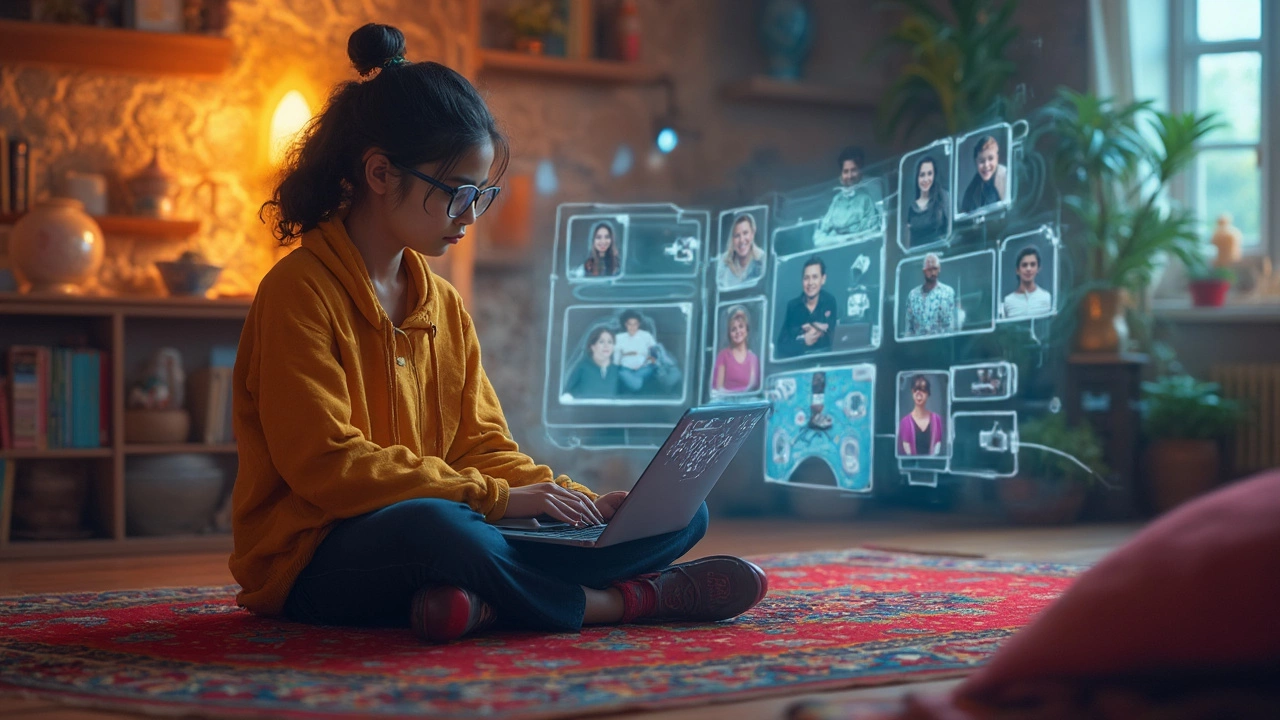Apr
11

- by Dhruv Ainsley
- 0 Comments
Ever wondered why distance education is such a big deal? It's like opening a magic portal where students learn without the need to sit in a physical classroom. Simple, right? You can think of it as education unplugged—giving you the power to access courses from anywhere, even if you’re in a different city or country from your school!
With technology playing such a huge role, let's be honest, our lives have become way more convenient. Imagine attending a class in your pajamas! You still learn, still interact with teachers and classmates, but all through screens. Forget long commutes or strict schedules; here, you set your pace and place.
But it's not just about convenience. Distance education has opened doors for people who might have found it challenging to pursue learning the traditional way. Busy professionals, parents (like me juggling Amaya's soccer practice and meetings), or anyone, can make it work with a bit of planning. And, there are tons of resources and support systems designed to help you succeed without stepping into a crowded lecture hall.
- Understanding Distance Education
- The Role of Technology
- Flexibility and Accessibility
- Challenges and Solutions
- Tips for Success in Distance Learning
Understanding Distance Education
Alright, let's get into what distance education really means. Essentially, it's all about learning without having to be in a traditional classroom. Think of it as education going digital. You can study from anywhere in the world as long as you have an internet connection. This is all thanks to tech advancements like the internet, digital platforms, and even virtual classrooms.
The beauty of online learning isn't just about avoiding the morning rush hour. It's about making education accessible to everyone, no matter where you live. Did you know that over 6 million students in the U.S. alone were taking at least one distance education course back in 2020? That's a massive shift towards remote learning.
So how does it work? Well, you'd typically interact with your teachers and classmates through video conferencing tools, discussion forums, and emails. Schools use platforms like Blackboard or Moodle where students can access materials, submit assignments, and even take tests. This means education institutions are investing heavily in educational technology to ensure students get the support they need.
There are also some misconceptions, like thinking distance learning is easier or less effective. Honestly, it's not. It requires discipline, self-motivation, and good time management skills. But with the flexibility it offers—say, if you're working or parenting like crazy—it can be the perfect solution.
| Year | Number of Distance Learners (in millions) |
|---|---|
| 2015 | 5.8 |
| 2020 | 6.9 |
| 2025 (projected) | 8.0 |
Whether you're looking to change careers, upskill, or finally tackle that degree you've always wanted, distance education can be the key to unlocking your educational dreams. Just remember, it's all about what works best for your individual needs and lifestyle.
The Role of Technology
Technology is the backbone of distance education. Can you picture online classes without the internet? Sounds like a joke, right? But seriously, technology turns the concept of learning remotely into a reality. Platforms like Zoom, Google Classroom, and Microsoft Teams are household names now, basically acting as the virtual classroom where teachers and students connect.
Why is technology so crucial? Well, it does more than just allow us to talk face-to-face digitally. It provides access to a treasure trove of resources. Thanks to educational technology, students can explore an endless library of ebooks, videos, and interactive courses without leaving their couch. It's a game-changer!
Ever heard of Learning Management Systems (LMS)? These platforms, like Moodle and Canvas, keep everything organized. Students submit assignments, get grades, and check out the syllabus all in one place. It's like having a personal school portal. And let's not forget about cloud services like Google Drive, making collaboration super easy.
Here's a fascinating bit: a survey found that over 80% of educators see technology as a way to connect real-world applications to course content. This means your education isn't just theoretical; you're getting hands-on experience with tools you'll likely use in your career.
Technology makes education more interactive, too. Tools like Kahoot and Quizlet offer engaging ways to test knowledge and build skills. And with virtual simulations and labs, students can perform experiments, visualize data, and dive into complex subjects without a physical lab.
In a nutshell, online learning thrives because technology removes the traditional barriers to education, making it accessible, engaging, and practical. It’s the backbone that holds it all together!

Flexibility and Accessibility
When it comes to distance education, flexibility is probably the biggest win. We're talking about learning that's as flexible as your yoga teacher. You can set your own hours to study, fit it around your work schedule, or squeeze in a class while your little one naps. No need to stress about missing classes just because life threw a curveball. Everything's at your pace, your place.
Accessibility is another game-changer. All you need is a device and a decent internet connection. Say goodbye to being bound by geography or limited by mobility. Whether you're chilling at a café in Melbourne or tucked away in a quiet corner of a library, you can hop into your virtual classroom with ease. And it's not just about location—it's also about access to a wider range of courses and experts that might not be available in your area.
Here's the cool part: many programs offer 24/7 access to resources. Missed something during the lecture? No worries! Just rewind and catch up. You can also tap into a plethora of online resources like e-books, recorded lectures, and discussion forums. This kind of online learning means you never completely miss out, even if life gets hectic.
And don’t fret about interaction or support. Many online learning platforms have stepped up their game with real-time chat options, video calls, and responsive support teams to help you whenever you hit a roadblock.
The numbers tell the story too. For instance, studies suggest that students engaged in educational technology platforms report higher satisfaction levels due to the freedom and resources available to them.
So, if you're thinking of jumping into distance learning, know this: it's designed to fit around your life, not the other way around. How's that for making education accessible?
Challenges and Solutions
Alright, let's not sugarcoat it—distance education comes with its own set of hurdles. But here's the kicker, every challenge has a workaround!
First up, staying motivated while learning from home can be tough. Without a teacher physically present to nudge you, distractions around the house can easily take over. The solution? Setting up a dedicated study space can create a school-like environment right at home. Keep it neat, have all your books and gadgets in place, and you've got yourself a mini-classroom!
Another major hiccup is feeling isolated. Let's face it, sometimes watching lectures alone just doesn’t cut it. Connecting virtually with classmates through discussion boards or study groups can make a huge difference. Platforms like Zoom, Microsoft Teams, or even Facebook study communities offer spaces to chat, discuss ideas, and build a support system.
Access to reliable technology is no small issue, either. The last thing you need is poor internet messing up your learning vibe. Upgrading to a stable internet connection is crucial. Schools often offer resources or support programs to assist. And remember, public libraries can be life-savers with public computers and Wi-Fi access!
Juggling time can also become a nightmare if not handled well. Following a structured routine, using tools like Google Calendar, or setting reminders on your phone can help. It's about making the most of your flexibility without letting things slip.
Let’s look at some existing data to understand the impact of these challenges:
| Challenge | Reported Impact |
|---|---|
| Lack of motivation | 35% of students find this affects their grades |
| Technology issues | Affects 22% of students regularly |
| Time management | 28% struggle to balance time effectively |
Tackling these challenges head-on not only makes online learning manageable but also a rewarding experience. It's about turning problems into stepping stones for better learning.

Tips for Success in Distance Learning
Alright, so you’ve decided to jump into the world of distance education. It's exciting but can feel a bit overwhelming, right? Don’t worry; we’ve got some practical tips to help you ace this.
First things first, creating a dedicated study space is a game changer. Whether it’s your kitchen table or a cozy corner in your room, make sure it’s clutter-free and has everything you need, like your laptop and books, within reach. This helps your brain switch into learning mode.
Next up, set a schedule that works for you. The beauty of online learning is flexibility, but that doesn’t mean winging it. Use calendars or tools like Google Calendar to block off study times. Having a routine keeps you disciplined.
Also, don’t shy away from using the tech tools available. Platforms like Zoom or Microsoft Teams aren't just fancy tools; they're there to help you stay connected and engaged. Mastering these can make your learning experience smoother.
Engagement is key in a virtual environment. Actively participate in discussions, whether it’s forums or live sessions. Ask questions and don’t hesitate to reach out to instructors if you’re stuck. They're there to help, even virtually!
- Join online study groups: Collaborating with peers can deepen your understanding.
- Take breaks: Just like in a physical class, breaks help keep your mind fresh. Try the Pomodoro technique – 25 minutes of focused study followed by a 5-minute break.
- Evaluate and adjust: Regularly review what’s working for you and what’s not. Flexibility is your friend.
And if stats are your thing, did you know that students in some studies reported a 25% increase in retention rates thanks to the tailored pace of distance learning? Pretty impressive, right?
| Factor | Impact on Success |
|---|---|
| Dedicated Study Space | Improves Focus |
| Schedule | Enhances Discipline |
| Technology Use | Increases Engagement |
So, there you have it! Dive in with a plan, stay organized, and use the tech tools available. You might just find that distance learning becomes one of the best educational experiences you ever have.





